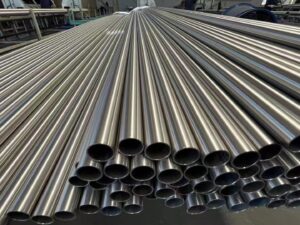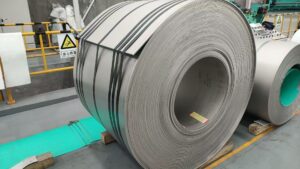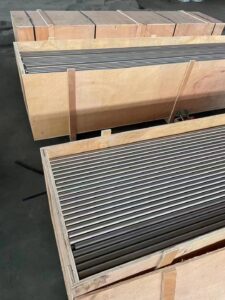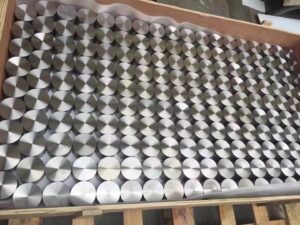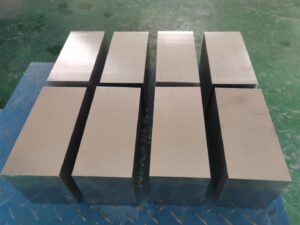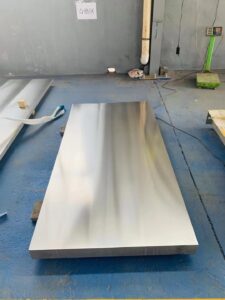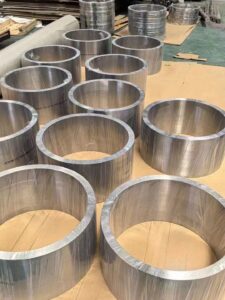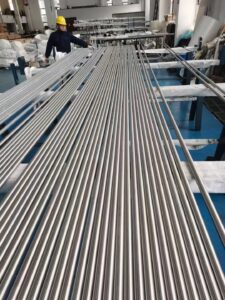Heat Treatment Of Titanium And Titanium Alloys
1. What is titanium alloy heat treatment?
Titanium alloy heat treatment is a heating process in which titanium materials are heated, insulated and cooled to change the structure and properties of titanium. Titanium alloy heat treatment is to improve the mechanical and physical properties of metal materials. Give full play to the potential of titanium materials.
The heat treatment of titanium alloy materials is the most widely used annealing and solution aging processes.
2. Titanium alloy annealing
The annealing of titanium materials includes stress annealing, full annealing, double annealing, isothermal annealing and vacuum annealing. The principle of annealing is to restore and recrystallize the microstructure of titanium changes process.
2.1 Reply of titanium alloy
Titanium material after cold deformation processing, its crystal deformation and dislocation, titanium is in a metastable state, titanium material in a metastable state, should be heated at low temperature, heating process, after movement, titanium crystal shape and size no significant changes, but after the recovery, the microstructure of titanium material changes significantly. The temperature at which titanium material recovers is lower than the recrystallization temperature, generally 500-650 degrees Celsius.
2.2 Recrystallization of titanium alloy
After cold processing deformation, titanium material is heated, new grains are generated in the original deformed organization, and the performance changes significantly, so as to return to the soft state, this process is the recrystallization process of titanium.
The microstructure of recrystallization can reflect the size and uniformity of grain. In general, the factors that affect the grain are:
Composition of titanium: The higher the composition and impurity content of titanium and titanium alloys, the easier it is to obtain fine grains of recrystallization. Because titanium and titanium alloy elements or impurities will hinder the grain boundary migration of titanium grain material, which is conducive to obtaining fine grains.
Degree of deformation of titanium and titanium alloys. The larger the deformation degree, the larger the deformation energy in titanium and titanium alloys, the more beneficial the energy release of titanium tissues.
Heating temperature and holding time. Generally speaking, the longer the heating temperature and holding time, the more conducive to the formation of grains.
2.3 Stress relief annealing
Stress relief annealing is also incomplete annealing, mainly to eliminate the internal stress generated in cold working or welding processes. The annealing temperature should not be too high, the general recrystallization temperature below 50-200 degrees Celsius, about 450-650 degrees Celsius.
2.4 Full annealing
The complete annealing of titanium and titanium alloys causes recrystallization within their tissues. After complete annealing, the internal structure and properties of titanium and titanium alloy are uniform and completely softened. And has the appropriate shape and toughness, so as to obtain the recrystallization structure, called recrystallization annealing. Generally, the annealing temperature is selected to be 100-200 degrees Celsius higher than the start temperature of recrystallization.
2.5 Isothermal annealing and double annealing
Isothermal annealing is to heat the titanium alloy above the recrystallization temperature, and then transfer it to another furnace for furnace cooling, cooling it to the temperature range of β phase with high stability, and finally cooling it in the air.
Double annealing is composed of two heating, two holding and two air cooling processes.
2.6 Vacuum Annealing
Sometimes titanium materials need vacuum annealing process, such as titanium plate, titanium coil, titanium tube, titanium rod and other semi-finished products before processing, need to go through intermediate annealing and surface treatment after cold processing and final annealing, so vacuum annealing is required.
3 .Solution and aging treatment
Solution and aging treatment are the main processes of heat treatment strengthening of titanium and titanium alloys.
3.1 Solution treatment
The solution treatment of titanium alloys is the process of heating titanium and titanium alloys, holding heat and cooling them quickly to room temperature. In order to achieve rapid cooling, the quenching method must be used. The purpose of solid solution is to retain the metastable phase, and the cooling method using water quenching must be carried out quickly. The quenching time affects the mechanical properties of the quenching state. Generally, the quenching delay time is not more than 10s, and the requirements are higher for titanium sheets.
3.2 Aging Treatment
Aging treatment is the process of heating titanium alloy to the appropriate temperature after quenching and cooling. The purpose of aging treatment is to promote the metastable phase of solid solution treatment to decompose in a certain way to achieve the purpose of strengthening.
TOP STAR METAL MATERIALS CO.,LTD is specialized in providing titanium and titanium alloy products, titanium rods, titanium plates, titanium tubes, titanium forging, titanium rings, titanium coils, titanium flanges, titanium workpieces and other materials.

